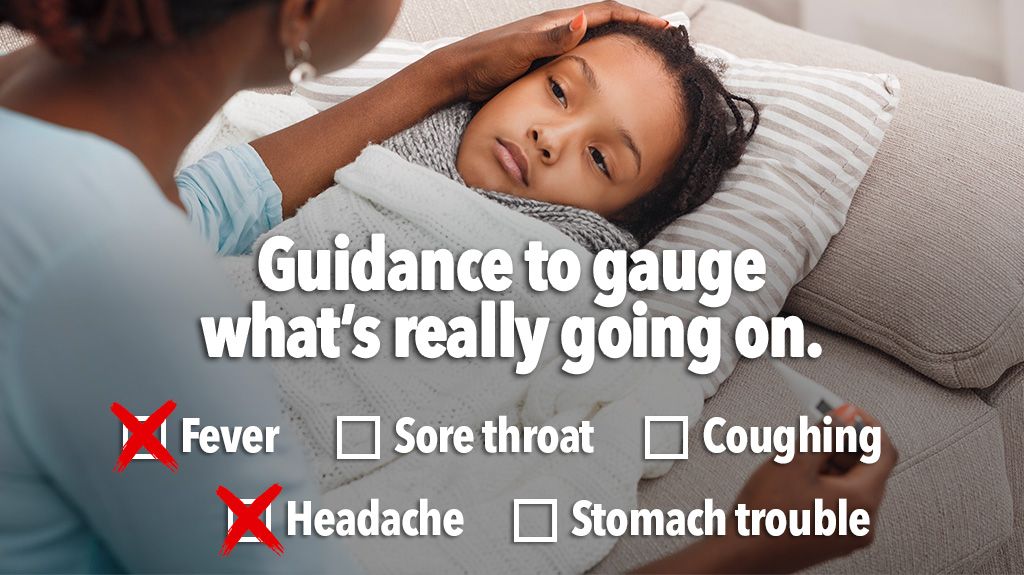How to Know If Kids’ Symptoms Are Suspicious
August 16, 2023

Send Them to School? Or Head to Urgent Care?
Guidelines for suspiciously sick-ish kids…
It’s always been tricky to know when to keep a child home from school and when to seek medical help. Because most adults-now-caregivers recall having played sick as a child, it used to be easy to send a ‘suspiciously’ sick kid to school. Now, as we remain hyper vigilant after the pandemic, people with children are unsure when it is and isn’t okay to ignore the complaints and pack the kids off to school. Keep reading for guidelines about when to keep a child home and when to head to a Texas MedClinic.
First, here’s what’s at stake:
+ The reason to send kids to school? Regular attendance is directly linked to academic and social-emotional success.
+ The reason to keep them home? Besides avoiding the spread of an illness, a day of rest will help your child recover.
+ The reason to pay attention? Recurring ‘sick’ complaints can indicate a bigger social, emotional or academic issue. Speak with your child’s teacher if you spot a chronic don’t-want-to-go-to-school pattern taking hold.
The most common symptoms of run-of-the-mill illnesses like the cold, flu, RSV and now COVID are:
- Fever
- Sore throat
- Coughing
- Headache
- Abdominal complaints
- Pinkeye
- Just ‘not right’

6 Tips to Assess Sickness by Symptom
Get a sense of what’s real by observing your child’s symptoms. Here are some tips:
1: Fever: This is the best measure of illness. If your child has a temperature of 100.4 degrees, they should stay home until they’ve been fever-free for 24 hours. To trust your temperature reading, make sure your child hasn’t had anything to drink or eat for 15 minutes and ensure physical calm for 20 minutes before taking a temperature. A fever is a sign of a systemic illness and should be carefully monitored. If your child’s temperature is greater than 102.0, evaluation in the urgent care is recommended.
2: Sore throat: A symptom of many common illnesses to which kids are susceptible, a sore throat could be anything from allergies to strep throat. Most sore throats will go away on their own, but strep is particularly painful and can make swallowing, talking and eating uncomfortable. If your child has had a sore throat for more than a couple of days or is in a lot of pain, head to urgent care. It may be strep sore throat, which is very contagious, can cause severe illness and needs to be treated with antibiotics.
3: Coughing: These are usually related to upper-respiratory infections. You’ll know a real cough when you hear one: it generally sounds wet, and forceful. It’s hard for a child to fake this for long before forgetting to maintain the ruse, so keep your ear out. If there’s wheezing, shortness of breath or a high fever, head to urgent care.
4: Headache: This is the hardest one to assess — even for professionals. But crying, closed eyes and lack of interest in play mean you should take your child’s word for it. Pain relievers should help after an hour or two. If not, head to urgent care. (Visit our blog for guidance about which pain reliever to give your child.) Headaches can also be a sign of other infectious problems and should be evaluated.
5: Abdominal complaints: Nausea, vomiting and diarrhea are easy to verify and kids with these symptoms should stay home. But stomach pain without any other symptoms (loss of appetite, clammy skin, fever) probably doesn’t warrant a day at home. Of course, severe pain is another story, and you should head to urgent care.
6: Pink eye: This is commonly a viral illness, but it can also be a bacterial infection that needs to be treated with antibiotic drops. The red, itchy eyes typical of pink eye can also be caused by COVID-19.
When to Go to Urgent Care
Some symptoms could indicate a serious illness requiring immediate medical attention. Visit a Texas MedClinic (or, if symptoms are severe, an emergency room) if your kiddo has a fever WITH any of the following symptoms:
- Vomiting or diarrhea.
- Stiff neck.
- Headache.
- Swollen joints.
- Very specific (localized) pain.
- Refusal to drink.
- Earache.
Finally, from all of us at Texas MedClinic, we’re wishing you a safe and healthy 2023-2024 school year. Getting plenty of sleep, drinking lots of water and frequent handwashing will help you have the healthiest year possible. Of course, we’re here to help if you need us!
Reviewed by: Frank Garber, Jr., APRN, FNP-C





